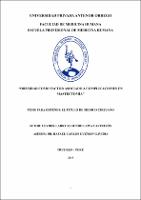Mostrar el registro sencillo del ítem
Obesidad como factor asociado a complicaciones en mastectomía
| dc.contributor.advisor | Guzman Gavidia, Rafael Carlos | |
| dc.contributor.author | Leiva Castrejón, Leyder Larry Segundo | |
| dc.creator | Leiva Castrejón, Leyder Larry Segundo | |
| dc.date.accessioned | 2019-08-13T16:34:41Z | |
| dc.date.available | 2019-08-13T16:34:41Z | |
| dc.date.issued | 2019 | |
| dc.identifier.uri | https://hdl.handle.net/20.500.12759/5248 | |
| dc.description.abstract | Objetivo: Determinar si la obesidad es un factor asociado a la aparición de complicaciones en pacientes tratadas con mastectomía. Material y métodos: Este estudio corresponde a un diseño de casos y controles, analítico de corte transversal. Se incluyó a 266 pacientes con diagnóstico de Cáncer de mama, sometidas a Mastectomía Unilateral o Bilateral en el Instituto Regional de Enfermedades Neoplásicas del Norte (IREN). El estudio de hizo a través de historias clínicas de Enero del 2015 a Diciembre del 2018, provistas por el servicio de archivo del mismo hospital, durante 5 semanas. Se utilizó una hoja de recolección de datos comprendiendo edad, diagnóstico, comorbilidades, cirugía realizada y complicaciones presentadas. Resultados: En esta investigación, de 266 pacientes, se dividió en grupos 133 para controles y 133 para casos. La edad promedio de todos los pacientes fue de 57.41 ± 12.97 años. El 100% de los pacientes fueron sometidos a mastectomía. El estadio IIA de cáncer de mama fue el más frecuente. El 10.9% de los pacientes tuvo diabetes mientras que el 19.2% tuvo hipertensión arterial. El 26.7% de los pacientes fueron obesos. La mitad de los pacientes tuvo alguna complicación, siendo la más frecuente el seroma. En total, se registró 71 pacientes obesas, de las cuales 58 (81.7%) tuvieron complicaciones comprendidas entre seroma, hematoma, linfedema e infección de sitio operatorio. Mediante el análisis univariado se determinó que la obesidad es un factor de riesgo para la presencia de complicaciones (OR 7.14, IC 95%: 3.67 – 13.9, p < 0.05) y predispone a la presencia de seroma, hematoma e infección del sitio operatorio. El análisis multivariado de regresión logística binaria mostró que la obesidad es factor de riesgo individual para la presencia de complicaciones, seroma, hematoma e infección de sitio operatorio, luego de controlar las variables edad, estadio de cáncer, diabetes e hipertensión arterial. Conclusiones: La obesidad sí es un factor asociado a la aparición de complicaciones en pacientes obesas tratadas con mastectomía OR 8.44 ( IC:95% , 3.97 - 17.92). | es_PE |
| dc.description.abstract | Objective: Determinate the association between obesity and complications on patients treated with mastectomy. Method: This study has a case-control design, analytic and transversal. It included 266 patients with Breast cancer diagnosis, they where treated with Unilateral or Bilateral Mastectomy in the Neoplasia Deseases Regional Institute of the North (IREN). The study was done through clinical records provided by the archives service of the same hospital, during 5 weeks. We used a collecting data format including age, diagnosis, comorbidities, surgical procedure and complications appeared. Results: In this study of 266 patients, it was divided into two groups: 133 for controls and 133 for cases. The average age of all patients was 57.41 ± 12.97 years. 100% of the patients underwent mastectomy. Stage IIA of breast cancer was the most frequent. 10.9% of patients had diabetes while 19.2% had high blood pressure. 26.7% of the patients were obese. Half of the patients had some complication, the most frequent being seroma. In total, 71 obese patients were registered, of which 58 (81.7%) had complications including seroma, hematoma, lymphedema and surgical site infection. The univariate analysis determined that obesity is a risk factor for the presence of complications (OR 7.14, 95% CI: 3.67 - 13.9, p <0.05) and predisposes to the presence of seroma, hematoma and surgical site infection. The multivariate binary logistic regression analysis showed that obesity is an individual risk factor for the presence of complications, seroma, hematoma and operative site infection, after controlling the age, cancer stage, diabetes and hypertension variables. Conclusions: Obesity is an associated factor to complications appearance in obese patients treated with mastectomy OR 8.44 ( IC:95% , 3.97 - 17.92). | en_US |
| dc.description.uri | Tesis | es_PE |
| dc.format | application/pdf | es_PE |
| dc.language.iso | spa | es_PE |
| dc.publisher | Universidad Privada Antenor Orrego | es_PE |
| dc.relation.ispartofseries | T_MED.HUMA_2606 | |
| dc.rights | info:eu-repo/semantics/openAccess | es_PE |
| dc.rights.uri | https://creativecommons.org/licenses/by/4.0/ | es_PE |
| dc.source | Universidad Privada Antenor Orrego | es_PE |
| dc.source | Repositorio Institucional - UPAO | es_PE |
| dc.subject | Mastectomía | es_PE |
| dc.subject | Complicaciones | es_PE |
| dc.title | Obesidad como factor asociado a complicaciones en mastectomía | es_PE |
| dc.type | info:eu-repo/semantics/bachelorThesis | es_PE |
| thesis.degree.level | Título Profesional | es_PE |
| thesis.degree.grantor | Universidad Privada Antenor Orrego. Facultad de Medicina Humana | es_PE |
| thesis.degree.name | Médico Cirujano | es_PE |
| thesis.degree.discipline | Medicina Humana | es_PE |
| dc.subject.ocde | https://purl.org/pe-repo/ocde/ford#3.02.27 | es_PE |
| renati.type | https://purl.org/pe-repo/renati/type#tesis | es_PE |
| renati.level | https://purl.org/pe-repo/renati/level#tituloProfesional | es_PE |
| renati.discipline | 912016 | es_PE |
| dc.publisher.country | PE | es_PE |
Ficheros en el ítem
Este ítem aparece en la(s) siguiente(s) colección(es)
-
Medicina Humana [2969]


